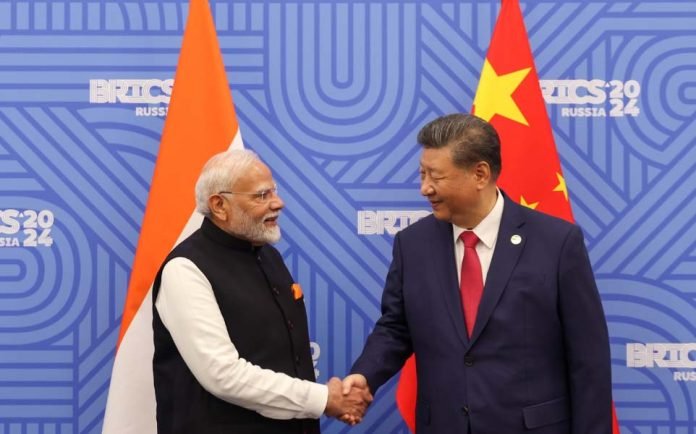Understanding the complexity of geopolitics in Asia is not easy. In the context of India-China relations, this complexity is awfully glaring. Despite a trust deficit, which widened further after the June 2020 Galwan Valley incident, both are inching forward to restart a new life.
To this regard, Prime Minister Narendra Modi’s statement that “the differences are natural. When the two neighbouring countries exist, occasional disagreements are bound to happen,” reflects New Delhi’s move to forget the pain that China had inflicted on India in east Ladakh region in the summer of 2020.
But a cursory glance at recent activities between India and China shows that on the ground, robustness of relations is still a far cry despite high-level political and official-level meetings between the two countries since Prime Minister Narendra Modi’s talks with Chinese President on the sidelines of the 16th BRICS summit at Kazan in Russia in October last year.
No Substantial Change on the Ground
Tension has eased between the two countries following the October 2024 agreement on troop disengagement at two friction points at Demchok and Depsang Plains and, also patrolling has been restored in these two areas of eastern Ladakh. Yet significant material change by China on the ground is missing.
A cursory glance at recent activities between India and China shows that on the ground, robustness of relations is still a far cry despite high-level political and official-level meetings between the two countries
For instance, China has still thousands of troops deployed on the front lines. Besides, it has built additional accommodation to billet reinforcements and advanced weaponry systems on the border. Then, China has plans to build 35 military or dual-use airports and major arterial railways and roads along the border in Tibet.
This has alarmed Indian armed forces, forcing Army Chief General Upendra Dwivedi to maintain that a degree of standoff prevails along the Line of Actual Control (LAC). At the press conference on January 13, 2025 in New Delhi, he termed the situation on the LAC as “sensitive but stable” and that the Army’s deployment along the border is “balanced and robust.” It suggests that a small spark can turn into a blazing inferno because of the continued trust deficit between armed forces of the two countries.
China’s Tactical Engagement with India
Experts say Beijing has merely put a cover on its plans. They say China announced the establishment of two new counties – He’an County and Hekang County in the disputed Aksai China area, just after a Special Representative-level meeting between India’s NSA Ajit Doval and Chinese Foreign Minister Wang Yi in Beijing in December last year. Elaborating it further, they say that by setting up these counties, China will cover the entire Aksai Chin area, including the 38,000 sq. km area claimed by India.
China has still thousands of troops deployed on the front lines. Besides, it has built additional accommodation to billet reinforcements and advanced weaponry systems on the border. Then, China has plans to build 35 military or dual-use airports and major arterial railways and roads along the border in Tibet
Moreover, this move was adopted by Beijing after the Indian and Chinese troops completed the disengagement at Demchok and Depsang Plains on October 28, 2024. These developments, as per China experts, indicate that Beijing has only tactically managed its engagement with New Delhi. In truth, experts say, China has no wish to see India as a friend and it is implicit in President Xi Jinping’s speech at the 20th National Congress of the CPC, which was held in October 2022.
Although the Chinese President did not explicitly label India as China’s key rival, his speech emphasising the “great rejuvenation of the Chinese nation,” underscored Beijing’s ambition of becoming a great power, asserting its influence in the Indo-Pacific region and beyond. It categorically suggests China’s competitive stance towards neighbouring countries, including India.
Plenty of Symbolism, But Lack of Substance on the Ground
In this context, initiatives like resumption of the Kailash Mansarovar Yatra, the restoration of direct flights, and facilitation of people-to-people exchanges are viewed as having only symbolic significance. These measures, in effect, fall short of fostering genuine trust between India and China, as they lack the substantial foundation of lasting confidence.
This is clearly evident in China’s stance on the issue of buffer zones on the Line of Actual Control. A buffer zone, serving as a demilitarised area, is created to reduce the risk of any accidental encounters, and the escalation of tensions. However, China remains unwilling to establish such a zone on the LAC, fearing it could become points of leverage for India.
Among experts, there is a belief that China, which has maintained a historically deceitful and biased approach towards India since the formation of the Communist Party of China in 1949, has merely made a temporary adjustment with its Southern neighbour, for the time being.
Experts say Beijing has merely put a cover on its plans. They say China announced the establishment of two new counties – He’an County and Hekang County in the disputed Aksai China area, just after a Special Representative-level meeting, and this move will allow China to cover the entire Aksai Chin area, including the 38,000 sq. km area claimed by India, as its territory
China’s Temporary Adjustment with India
They say there are two reasons for such adjustments: First, it is facing challenges from the US and its allies in the South China Sea and the Taiwan Strait. In the Indo-Pacific region, its continued military-led assertiveness in the South China Sea has soured relations with the Philippines, Vietnam, Indonesia, and Malaysia. With Japan, it is not sharing a good relationship as well, because of the Senkaku Islands.
Second, its economy is facing headwinds; imposition of a 20% tariff on Chinese products by the US under the Trump administration will further hit its decelerating economy hard. It is hard-pressed to find the money needed to stimulate consumption. While layoffs have increased, the rate of unemployment for those between the age of 16 and 24 nearly hit 20% in January 2025, said Dow Jones &Company owned Market Watch.
The long-running real estate crisis has further deepened in the country with real estate investment falling 9.8% in the first two months of the current year. In China, around 70% of family assets are held in property, and housing accounts for around 20% of the economy. Economists say China is to face a more pronounced slowdown and in 2025 too, it is not going to record 5% growth.
There is a belief that China, which has maintained a historically deceitful and biased approach towards India since the formation of the Communist Party of China in 1949, has merely made a temporary adjustment with its Southern neighbour, for the time being
Additionally, there are growing concerns among experts and analysts that, once China’s economy recovers, it may revive its aggressive policies and designs against India. This fear stems from the longstanding tensions between the two giant Asian neighbours. To prevent direct confrontation between the armies of the two countries, they have agreed for a staggered patrol timing. They have also agreed for activating hotlines at the battalion and brigadier level.
Yet, scepticism remains. Since these hotlines are not established at the highest decision-making levels, there is likelihood that they may not function effectively on the ground, as have been experienced by the Philippines and Vietnam during their respective skirmishes with the PLA Navy in the South China Sea in the recent past. In this background, the question of how long and how effectively India and China can manage their relations and avoid the return of the Galwan Valley-like situation is open to debate.
–The writer is a senior journalist with wide experience in covering international affairs. The views expressed are of the writer and do not necessarily reflect the views of Raksha Anirveda






